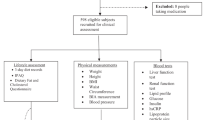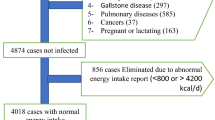Abstract
Objective:
To examine the relationship between dietary carbohydrates, glycemic load and high-density lipoprotein cholesterol (HDL-C) concentrations in Asian Indians, a high-risk group for diabetes and premature coronary artery disease.
Subjects/methods:
The study population comprised of 2043 individuals aged ⩾20 years randomly selected from Chennai Urban Rural Epidemiological Study (CURES), an ongoing population-based study on a representative population of Chennai (formerly Madras) city in southern India. Participants with self-reported history of diabetes or heart disease or on drug therapy for dyslipidemia were excluded from the study. Dietary carbohydrates, glycemic index and glycemic load were assessed using a validated interviewer administered semiquantitative Food Frequency Questionnaire (FFQ).
Results:
Both dietary glycemic load (P<0.0001) and total dietary carbohydrate intake (P<0.001) were significantly associated with higher serum triglyceride levels and lower serum HDL-C levels. For the lowest to highest quintile of glycemic load, the multivariate-adjusted mean HDL-C values were 44.1 mg per 100 ml and 41.2 mg per 100 ml (6.6% difference, P for trend<0.001), while for total carbohydrate it was less (5% difference, P for trend=0.016). The pattern of decrease in HDL-C for the lowest to highest quintile of glycemic load was more pronounced among men (1st vs 5th quintile: adjusted HDL-C: 4.3 mg per 100 ml decrease (10.3%)) than women (1st vs 5th quintile: adjusted HDL-C: 3.2 mg per 100 ml decrease (6.9%)).
Conclusion:
Our findings indicate that both total carbohydrates and dietary glycemic load intake are inversely associated with plasma HDL-C concentrations among Asian Indians, with dietary glycemic load having a stronger association.
This is a preview of subscription content, access via your institution
Access options
Subscribe to this journal
Receive 12 print issues and online access
$259.00 per year
only $21.58 per issue
Buy this article
- Purchase on Springer Link
- Instant access to full article PDF
Prices may be subject to local taxes which are calculated during checkout
Similar content being viewed by others
References
Amano Y, Kawakubo K, Lee JS, Tang AC, Sugiyama M, Mori K (2004). Correlation between dietary glycemic index and cardiovascular disease risk factors among Japanese women. Eur J Clin Nutr 58, 1472–1478.
Anwar TM, Sonia SA, Linda EK, Vuksan V, Jacobs R, Davis B, et al., for the SHARE and SHARE-AP Investigators (2007). Carbohydrate intake and HDL in a multiethnic population. Am J Clin Nutr 85, 225–230.
Beckles GL, Miller GJ, Kirkwood BR, Alexis SD, Carson DC (1986). High total and cardiovascular disease mortality in adults of Indian descent in Trinidad, unexplained by major coronary risk factors. Lancet 1, 1298–1301.
Betty WL, Karen WA, Plamela RP (2002). Individual sugars, soluble and insoluble dietary fiber contents of 70 high consumption foods. J Food Compost Anal 15, 715–723.
Burkitt DP, Trowell HC (1977). Dietary fibre and western disease. Ir Med J 70, 272–277.
Deepa M, Pradeepa R, Rema M, Mohan A, Deepa R, Shanthirani S et al. (2003). The Chennai Urban Rural Epidemiology Study (CURES)—study design and methodology (urban component) (CURES-I). J Assoc Physicians India 51, 863–870.
Enas EA, Garg A, Davidson MA (1996). Coronary heart disease and its risk factors in first-generation immigrant Asian Indians to the United States of America. Indian Heart J 48, 343–352.
FAO/WHO (1998). Carbohydrates in human nutrition. Report of a joint FAO/WHO report Rome 14-18 April. Paper 66: FAO Food and Nutrition.
Ford ES, Liu S (2001). Glycemic index and serum high-density lipoprotein cholesterol concentration among us adults. Arch Intern Med 161, 572–576.
Foster-Powell K, Holt SH, Brand-Miller JC (2002). International table of glycemic index and glycemic load values. Am J Clin Nutr 76, 5–56.
Gibson RS (1990). Food consumption of individuals. In: Principles of Nutritional Assessment. Oxford University Press: New York, 37–54.
Gopalan C, Ramashastri BV, Balasubramaniam SC (2004). Nutritive value of Indian foods. Revised and updated by Rao BSN, Deosthale YG and Pant KC. Published by National Institute of Nutrition, Indian Council of Medical Research, Hyderabad, India.
Gordan DJ, Probstfield JL, Garrison RJ (1989). High density lipoprotein cholesterol and cardiovascular disease. Circulation 79, 8–15.
Gordon T, The diet-heart idea (1988). Outline of a history. Am J Epidemiol 127, 220–225.
Grundy S, Denke M (1990). Dietary influences on serum lipids and lipoproteins. J Lipid Res 31, 1149–1172.
Grundy SM (1998). Hypertriglyceridemia, atherogenic dyslipidemia, and the metabolic syndrome. Am J Cardiol 81, 18B–25B.
Grundy SM, Abate N, Chadalia M (2002). Diet composition and the metabolic syndrome: what is the optimal fat intake? Am J Med 112 (Suppl) 9B, 25S–29S.
Gupta R (2005). Burden of coronary heart disease in India. Indian Heart J 57, 632–638.
Hellerstein MK (2002). Carbohydrate-induced hypertriglyceridemia: modifying factors and implications for cardiovascular risk. Curr Opin Lipidol 13, 33–40.
Jenkins DJA, Wolever TMS, Taylor RH (1981). Glycemic index of foods, a physiological basis for carbohydrate exchange list. Am J Clin Nutr 34, 362–366.
Knoop RH, Walden CE, Retzlaff BM, McCann BS, Dowdy AA, Albers JJ et al. (1997). JAMA 278, 1509–1515.
Liu S, Willett WC (2002). Dietary glycemic load and atherothrombotic risk. Curr Atheroscler Rep 4, 454–461.
Liu S, Manson JE, Stampfer MJ (2001). Dietary glycemic load assessed by food-frequency questionnaire in relation to plasma high-density-lipoprotein cholesterol and fasting plasma triacylglycerol in postmenopausal women. Am J Clin Nutr 73, 560–566.
Ludwig DS (2002). The glycemic index: physiological mechanism relating obesity, diabetes and cardiovascular diseases. JAMA 287, 2414–2423.
Mancini M, Mattock M, Rabaya E, Chait A, Lewis B (1973). Studies of the mechanisms of carbohydrate-induced lipaemia in normal man. Atherosclerosis 17, 445–454.
Mani UV, Bhatt S, Mehta NC, Pradhan SN, Shah V, Mani I (1990). Glycemic index of traditional Indian carbohydrate foods. J Am Coll Nutr 9, 573–577.
Mani UV, Mani IU, Iyer UM, Prakash B, Manivannan T, Campbell S et al. (1997). Glycemic and lipemic response to various regional meals and south Indian snacks. Int J Diab Dev countries 17, 75–82.
Mani UV, Prabhu BM, Damle SS (1993). Glycemic index of some commonly consumed food in western India. Asia Pacific J Clin Nutr 2, 111–114.
Mani UV, Pradhan SN, Mehta NC (1992). Glycemic index of conventional carbohydrate meals. Br J Nutr 68, 445–450.
McKeigue PM (1992). Coronary heart disease in Indians, Pakistanis and Bangladeshis: etiology and possibilities for prevention. Br Heart J 67, 341–342.
McKeigue PM, Shah B, Marmot MG (1991). Relation of central obesity and insulin resistance with high diabetes prevalence and cardiovascular risk in South Asians. Lancet 337, 382–386.
Mohan V, Deepa R (2004). Risk factors for coronary artery disease in Indians. J Assoc Physicians India 52, 95–97.
Mohan V, Gokulakrishnan K, Deepa R, Shanthirani C.S, Datta M (2005). Association of physical inactivity with components of metabolic syndrome and coronary artery disease-the Chennai Urban Population Study. Diabet Med 22, 1206–1211.
Mohan V, Shanthirani CS, Deepa R (2003). Glucose intolerance (diabetes and IGT) in a selected South Indian Population with special reference to family history, obesity and lifestyle factors: The Chennai Urban Population Study. J Assoc Physicians India 51, 771–777.
Murakami K, Sasaki S, Takahashi Y, Okubo H, Hosoi Y, Horiguchi Y et al. (2006). Dietary glycemic index and load in relation to metabolic risk factors in Japanese female farmers with traditional dietary habits. Am J Clin Nutr 83, 1161–1169.
Raghuram TC, Parischa S, Upadhayaya AC, Krishnaswamy K (1987). Glycemic index of Indian foods. Diabetes Bulletin 7, 64–66.
Ramachandran A, Snehalatha C, Viswanathan V, Viswanathan M, Haffner SM (1997). Risk of non-insulin dependent diabetes mellitus conferred by obesity and central adiposity in different ethnic groups: a comparative analysis between Asian Indians, Mexican Americans and Whites. Diabetes Res Clin Pract 36, 121–125.
Ravussin E, Valencia ME, Esparza J, Bennett PH, Schulz LO (1994). Effects of a traditional lifestyle on obesity in Pima Indians. Diabetes Care 17, 1067–1074.
Reddy KS, Yusuf S (1998). Emerging epidemic of cardiovascular disease in developing countries. Circulation 97, 596–601.
Salmeron J, Ascherio A, Rimm EB, Colditz GA, Spiegelman D, Jenkins DJ et al. (1997). Dietary fiber, glycemic load, and risk of NIDDM in men. Diabetes Care 20, 545–550.
Schmidhuber J, Shetty P (2005). The nutrition transition to 2030. Why developing countries are likely to bear the major burden. Acta Agriculturae Scandinavica, Section C – Economy 2, 150–166.
Sicree R, Shaw J, Zimmet P (2006). Diabetes and impaired glucose tolerance. In: Gan D (ed), Diabetes Atlas. International Diabetes Federation 3rd edn. International Diabetes Federation: Belgium. p. 15–103.
Sudha V, Radhika G, Sathya RM, Ganesan A, Mohan V (2006). Reproducibility and validity of an interviewer administered semi-quantitative food frequency questionnaire to assess dietary intake of urban adults in Southern India. Int J Food Sci Nutr 57, 481–493.
Thorburn AW, Brand JC, Trustwell AS (1987). Slowly digested and absorbed carbohydrate in traditional bush foods: a protective factor against diabetes. Am J Clin Nutr 45, 98–106.
Willet WC, Howe GR, Kushi LH (1997). Adjustment for total energy intake in epidemiologic studies. Am J Clin Nutr 65, 1220S–1228S.
Wolever TM, Jenkins DJ, Jenkins AL, Josse RG (1991). The glycemic index, methodology and clinical implications. Am J Clin Nutr 54, 846–854.
Yagalla MV, Hoerr SL, Song WO, Enas E, Garg A (1996). Relationship of diet, abdominal obesity, and physical activity to plasma lipoprotein levels in Asian Indian physicians residing in the United States. J Am Diet Assoc 96, 257–261.
Acknowledgements
We thank the Chennai Willington Corporate Foundation, Chennai for the CURES field studies. Special thanks to Ms R Tamilselvi and Ms M Ezhilarasi, research dietitians for their help with the manuscript. This is the 48th publication from Chennai Urban Rural Epidemiology Study (CURES 48).
Author information
Authors and Affiliations
Corresponding author
Additional information
Guarantor: V Mohan.
Contributor: GR and AG conducted the statistical analysis. GR wrote the manuscript and conceived the initial hypothesis. GR and RMS led the data collection. VS and VM contributed to the drafting of the paper and several revisions of the same. GR and VM were involved in the interpretation of data. All authors have contributed substantially to conception and design of the study or analyses and interpretation of the data. They approved the final version and will take public responsibility for the content of this paper. There are no conflicts of interest with any other organization.
Rights and permissions
About this article
Cite this article
Radhika, G., Ganesan, A., Sathya, R. et al. Dietary carbohydrates, glycemic load and serum high-density lipoprotein cholesterol concentrations among South Indian adults. Eur J Clin Nutr 63, 413–420 (2009). https://doi.org/10.1038/sj.ejcn.1602951
Received:
Revised:
Accepted:
Published:
Issue Date:
DOI: https://doi.org/10.1038/sj.ejcn.1602951
Keywords
This article is cited by
-
Dietary insulin index and load and cardiometabolic risk factors among people with obesity: a cross-sectional study
BMC Endocrine Disorders (2023)
-
Differential association of dietary carbohydrate intake with metabolic syndrome in the US and Korean adults: data from the 2007–2012 NHANES and KNHANES
European Journal of Clinical Nutrition (2018)
-
Socioeconomic Status and Glycemic Index Among Punjabis in Kuala Lumpur, Malaysia: Possible Association with Metabolic Syndrome
Journal of Immigrant and Minority Health (2018)
-
Interaction between FTO gene variants and lifestyle factors on metabolic traits in an Asian Indian population
Nutrition & Metabolism (2016)
-
Dietary glycaemic index and glycaemic load in a rural elderly population (60–74 years of age) and their relationship with cardiovascular risk factors
European Journal of Nutrition (2015)



